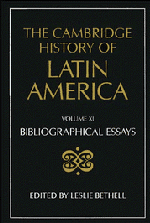Book contents
- Frontmatter
- I THE INDIGENOUS PEOPLES OF MIDDLE AND SOUTH AMERICA ON THE EVE OF THE CONQUEST
- II COLONIAL SPANISH AMERICA
- III COLONIAL BRAZIL
- IV THE INDEPENDENCE OF LATIN AMERICA
- V LATIN AMERICA: ECONOMY, SOCIETY, POLITICS, c. 1820 TO c. 1870
- VI LATIN AMERICA: ECONOMY, SOCIETY, POLITICS, c. 1870 to 1930
- 1 Latin America and the international economy, 1870–1914
- 2 Latin America and the international economy, 1914–1929
- 3 Population
- 4 Rural Spanish America
- 5 The growth of cities
- 6 Industry
- 7 The urban working class and early labour movements
- 8 The Catholic church
- 9 Mexico: Restored republic and Porfiriato, 1867–1910
- 10 The Mexican Revolution, 1910–1920
- 11 Mexico: Revolution and reconstruction in the 1920s
- 12 Central America
- 13 Cuba
- 14 Puerto Rico
- 15 The Dominican Republic
- 16 Haiti
- 17 Argentina: Economy, 1870–1914
- 18 Argentina: Society and politics, 1880–1916
- 19 Argentina, 1914–1930
- 20 Uruguay
- 21 Paraguay
- 22 Chile
- 23 Bolivia
- 24 Peru
- 25 Colombia
- 26 Ecuador
- 27 Venezuela
- 28 Brazil: Economy
- 29 Brazil: Society and politics, 1870–1889
- 30 Brazil: Society and politics, 1889–1930
- VII LATIN AMERICA: ECONOMY, SOCIETY, POLITICS, 1930 to c. 1990
- VIII IDEAS IN LATIN AMERICA SINCE INDEPENDENCE
- IX LATIN AMERICAN CULTURE SINCE INDEPENDENCE
- X THE INTERNATIONAL RELATIONS OF LATIN AMERICA SINCE INDEPENDENCE
- THE CAMBRIDGE HISTORY OF LATIN AMERICA
7 - The urban working class and early labour movements
from VI - LATIN AMERICA: ECONOMY, SOCIETY, POLITICS, c. 1870 to 1930
Published online by Cambridge University Press: 28 March 2008
- Frontmatter
- I THE INDIGENOUS PEOPLES OF MIDDLE AND SOUTH AMERICA ON THE EVE OF THE CONQUEST
- II COLONIAL SPANISH AMERICA
- III COLONIAL BRAZIL
- IV THE INDEPENDENCE OF LATIN AMERICA
- V LATIN AMERICA: ECONOMY, SOCIETY, POLITICS, c. 1820 TO c. 1870
- VI LATIN AMERICA: ECONOMY, SOCIETY, POLITICS, c. 1870 to 1930
- 1 Latin America and the international economy, 1870–1914
- 2 Latin America and the international economy, 1914–1929
- 3 Population
- 4 Rural Spanish America
- 5 The growth of cities
- 6 Industry
- 7 The urban working class and early labour movements
- 8 The Catholic church
- 9 Mexico: Restored republic and Porfiriato, 1867–1910
- 10 The Mexican Revolution, 1910–1920
- 11 Mexico: Revolution and reconstruction in the 1920s
- 12 Central America
- 13 Cuba
- 14 Puerto Rico
- 15 The Dominican Republic
- 16 Haiti
- 17 Argentina: Economy, 1870–1914
- 18 Argentina: Society and politics, 1880–1916
- 19 Argentina, 1914–1930
- 20 Uruguay
- 21 Paraguay
- 22 Chile
- 23 Bolivia
- 24 Peru
- 25 Colombia
- 26 Ecuador
- 27 Venezuela
- 28 Brazil: Economy
- 29 Brazil: Society and politics, 1870–1889
- 30 Brazil: Society and politics, 1889–1930
- VII LATIN AMERICA: ECONOMY, SOCIETY, POLITICS, 1930 to c. 1990
- VIII IDEAS IN LATIN AMERICA SINCE INDEPENDENCE
- IX LATIN AMERICAN CULTURE SINCE INDEPENDENCE
- X THE INTERNATIONAL RELATIONS OF LATIN AMERICA SINCE INDEPENDENCE
- THE CAMBRIDGE HISTORY OF LATIN AMERICA
Summary
The two modern general histories of the Latin American labour movements that cover the pre-1930 period in some depth are Hobart A. Spalding, Jr., Organized Labor in Latin America (New York, 1977), and Ricardo Melgar Bao, El movimiento obrero latinoamericano (Madrid, 1988). In Julio Godio, Historia del movimiento obrero latinoamericano, 2 vols. (Mexico, D.F., 1980–3), the first volume deals with the movements in Argentina, Mexico and Chile up to 1918, while the second treats communism and nationalism for the region as a whole between 1918 and 1930. Charles Bergquist, Labor in Latin America: Comparative Essays on Chile, Argentina, Venezuela, and Colombia (Stanford, Calif., 1986) provides four case studies informed by dependency theory. Robert Paris and Madeleine Rebérioux, ‘Socialisme et communisme en Amérique latine’, in Histoire générate du socialisme, Jacques Droz (ed.), (Paris, 1978), vol. 4, is an informative shorter survey. Pablo González Casanova (ed.), Historia del movimiento obrero en América Latina, 4 vols. (Mexico, D.F., 1984) is composed of chapters on each country in Latin America, including Puerto Rico. The authors are sometimes not very concerned with pre-1930 developments, and the theoretical approaches vary considerably from one chapter to another. Nevertheless, the collection is valuable, particularly in the case of the smaller countries, where the chapters included are sometimes the best or at least most accessible syntheses available.
The most comprehensive bibiliography remains Carlos Rama, L’Amérique latine: 1492–1936 (Mouvements ouvriers et socialistes) (Paris, 1959), also available in a later German edition: Die Arbeiterbewegung in Lateinamerica: Chronologie und bibliographie, 1492–1966 (Bad Homburg, 1967). Additional material can be found in Kenneth Paul Erickson, Patrick V. Peppe and Hobart A. Spalding, Jr., ‘Research on the urban working class and organized labor in Argentina, Brazil, and Chile: What is left to be done?’, LARR, 9/2(1974), 115–42.
- Type
- Chapter
- Information
- The Cambridge History of Latin America , pp. 359 - 375Publisher: Cambridge University PressPrint publication year: 1995



